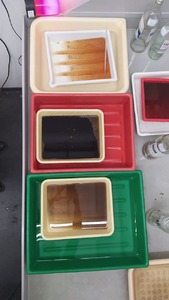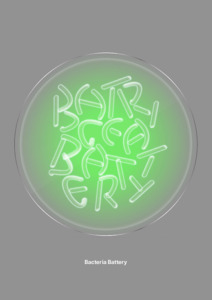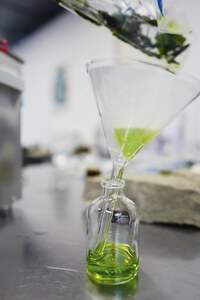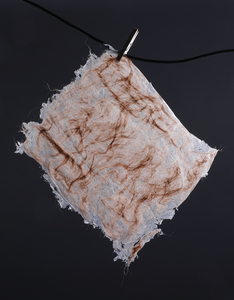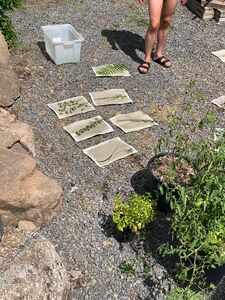Bio Design Lab

Bio Design Lab
7 Inhalte
- Seite 1 von 1
Photosymbiosen – On Co-Developing with Plant Accomplices
- Titel
- Photosymbiosen – On Co-Developing with Plant Accomplices
- Titel (en)
- Photosymbiosen – On Co-Developing with Plant Accomplices
- Untertitel
- Sustainable Photography
- Beschreibung (de)
- Wie können wir fotografische Verfahren entwickeln, die nicht auf einem Ausbeutungsverhältnis der Umwelt beruhen, sondern vielmehr mit nicht-menschlichen Akteuren in Kollaboration treten? Wenn auch ein solches Unterfangen aufgrund der anthropozentrischen Perspektive zu kurz kommen muss, so eröffnet jenes unmögliche Driften hin zum pflanzlicheren Denken ein Spannungsfeld der künstlerischen Auseinandersetzung. Vom Flanieren in den Wäldern, dem Sammeln von Kräutern bis hin zur Ambivalenz zwischen städtischem Raum, pflanzlicher Peripherie und Ruderaler Vegetation – all jene dynamischen Wechselverhältnisse eines geteilten Habitats stellen den gedanklichen Ausgangspunkt der Arbeiten von “Photosymbiosen – On Co-Developing with Plant Accomplices” dar. Neben dem Bemühen um einen Fotografischen Blick, der sich ins mutuale Beziehungsgeflecht jener Co-Existenzen einfügt, steht das Bildgebungsverfahren analoger, nachhaltiger Fotografie im Fokus der Recherche. Denn jene alte Technik, die in Zeiten digitaler Bilderflut zunehmend ein Comeback erfährt, stellt vor einige Herausforderungen:
So basiert jenes Verfahren der Bilderzeugung auf der Lichtempfindlichkeit von Silberhalogenidkristallen, die in einer Gelatineemulsion auf einem Filmträger (zur Herstellung des Negativs) und auf Papier (zur Herstellung des Fotos) aufgebracht sind. Um die Kristalle in metallisches Silber umzuwandeln und so ein (negatives) Bild auf Film zu erhalten, beziehungsweise es dann auf Papier zu verarbeiten und zu vergrößern (positives fotografisches Bild), ist es notwendig, verschiedene, hochgiftige chemische Lösungen zu verwenden. Diese Produkte sind nicht nur gesundheitsgefährdend für diejenigen, die mit ihnen umgehen, sondern stellen auch eine große Quelle für die Verschmutzung von Gewässern, Pipelines und ganz allgemein der Umwelt dar – und müssen daher in besonderer Weise entsorgt und behandelt werden. Darüber hinaus ist nicht nur die Giftigkeit dieser Bildentwicklungsmethode problematisch, sondern auch ihr Medium. Die auf Film und Papier aufgebrachte Gelatine ist tierischen Ursprungs – in der Regel eine Rindergelatine – und wird damit Teil der vielfältigen Probleme der Fleischindustrie. Letztlich macht die Industrialisierung der analogen Fotografie, von ihren chemischen Komponenten bis hin zur Entwicklung der Fotos in Labors, ihre Anwender abhängig von vorgefertigten, in der Regel teuren Produkten.
Getragen von dem Wunsch, neue experimentelle Formen der Kreation zu erforschen und die Umweltbelastung durch jene fotografische Technik zu reflektieren, wurden so verschiedene alternative Verfahren zur Reduktion von Chemikalieneinsatz entwickelt. Dabei gaben verschiedene internationale Initiativen aus dem Bereich der nachhaltigen Fotografie Inspirationen zur Herstellung eigener Schwarz-Weiß-Entwickler, die auf regionalen und saisonalen Pflanzen der städtischen Umgebung Karlsruhes basieren (Kräuter, Blätter, Blumen, Baumrinde, Moos, Gemüse, etc.). Die ausgestellten Werke geben Einblicke in die experimentelle Forschung, eine ergänzende Website gibt weitere Informationen zu Dokumentationen wie auch Herstellungsverfahren und Recherchen.
- Wie können wir fotografische Verfahren entwickeln, die nicht auf einem Ausbeutungsverhältnis der Umwelt beruhen, sondern vielmehr mit nicht-menschlichen Akteuren in Kollaboration treten? Wenn auch ein solches Unterfangen aufgrund der anthropozentrischen Perspektive zu kurz kommen muss, so eröffnet jenes unmögliche Driften hin zum pflanzlicheren Denken ein Spannungsfeld der künstlerischen Auseinandersetzung. Vom Flanieren in den Wäldern, dem Sammeln von Kräutern bis hin zur Ambivalenz zwischen städtischem Raum, pflanzlicher Peripherie und Ruderaler Vegetation – all jene dynamischen Wechselverhältnisse eines geteilten Habitats stellen den gedanklichen Ausgangspunkt der Arbeiten von “Photosymbiosen – On Co-Developing with Plant Accomplices” dar. Neben dem Bemühen um einen Fotografischen Blick, der sich ins mutuale Beziehungsgeflecht jener Co-Existenzen einfügt, steht das Bildgebungsverfahren analoger, nachhaltiger Fotografie im Fokus der Recherche. Denn jene alte Technik, die in Zeiten digitaler Bilderflut zunehmend ein Comeback erfährt, stellt vor einige Herausforderungen:
- Beschreibung (en)
- How can we develop photographic processes that are not based on a relationship of exploitation of the environment, but rather enter into collaboration with non-human actors? Even if such an endeavour must fall short due to the anthropocentric perspective, that impossible drift towards more plant-based thinking opens up a field of tension for artistic exploration. From strolling in the woods, collecting herbs to the ambivalence between urban space, plant periphery and ruderal vegetation – all those dynamic interrelationships of a shared habitat represent the intellectual starting point of the works of "Photosymbioses – On Co-Developing with Plant Accomplices". In addition to the effort to create a photographic gaze that fits into the mutual network of relationships of these co-existences, the research focuses on the imaging process of analogue, sustainable photography. This old technique, which is increasingly making a comeback in times of a flood of digital images, poses a number of challenges:
For example, this method of image creation is based on the light sensitivity of silver halide crystals, which are deposited in a gelatine emulsion on a film carrier (to produce the negative) and on paper (to produce the photograph). In order to convert the crystals into metallic silver and thus obtain a (negative) image on film, or then process and enlarge it on paper (positive photographic image), it is necessary to use various highly toxic chemical solutions. These products are not only hazardous to the health of those who handle them, but are also a major source of pollution of water, pipelines and the environment in general - and must therefore be disposed of and treated in a special way. Furthermore, it is not only the toxicity of this image development method that is problematic, but also its medium. The gelatine applied to film and paper is of animal origin - usually a bovine gelatine - and thus becomes part of the manifold problems of the meat industry. Ultimately, the industrialisation of analogue photography, from its chemical components to the development of the photos in laboratories, makes its users dependent on prefabricated, usually expensive products.
Driven by the desire to explore new experimental forms of creation and to reflect on the environmental impact of that photographic technique, various alternative methods for reducing chemical use were thus developed. In the process, various international initiatives from the field of sustainable photography provided inspiration for the production of own black-and-white developers based on regional and seasonal plants from Karlsruhe's urban environment (herbs, leaves, flowers, tree bark, moss, vegetables, etc.). The exhibited works provide insights into the experimental research, a complementary website gives further information on documentation as well as production processes and research.
- How can we develop photographic processes that are not based on a relationship of exploitation of the environment, but rather enter into collaboration with non-human actors? Even if such an endeavour must fall short due to the anthropocentric perspective, that impossible drift towards more plant-based thinking opens up a field of tension for artistic exploration. From strolling in the woods, collecting herbs to the ambivalence between urban space, plant periphery and ruderal vegetation – all those dynamic interrelationships of a shared habitat represent the intellectual starting point of the works of "Photosymbioses – On Co-Developing with Plant Accomplices". In addition to the effort to create a photographic gaze that fits into the mutual network of relationships of these co-existences, the research focuses on the imaging process of analogue, sustainable photography. This old technique, which is increasingly making a comeback in times of a flood of digital images, poses a number of challenges:
- Typ des Projekts/Werks
- Schlagworte
- Datierung
- Sommersemester 2021
- Mitwirkende
- Material
- Ort: Institution
- Stadt
- Land
- Internetlinks
- Titel
- Photosymbiosen – On Co-Developing with Plant Accomplices
- Semester
- Importiert am
- 30.10.2023
- Übergeordnete Sets
- 1
- Set enthält
- 0 33
Bacteria Battery
- Titel
- Bacteria Battery
- Titel (en)
- Bacteria Battery
- Beschreibung (de)
- Die Poesie grüner Energie – Auf der Suche nach regenerativer Stromerzeugung gehen wir für einen Tag eine spannende Verflechtung mit winzigen Mikro-Organismen ein. So zeigen uns die Bio Artists und Forscher Rasa Smite und Raitis Smits / RIXC in ihrem Hands-On Workshop, wie mit Hilfe von Elektroden und Schlamm sogenannte „Bakterien Batterien“ hergestellt werden können. Dabei bekommen wir nicht nur einen Einblick in die faszinierende Technologie Mikrobieller Brennstoffzellen, sondern auch in die unterschiedlichen Forschungsstände, die Studierende der HfG Karlsruhe hierzu in einem vorangegangenen, gleichnamigen Seminar während des letzten Semesters erarbeitet haben. Mit diesem theoretischen Input geht es anschließend an die eigene künstlerische useinandersetzung: In einer Schritt-für-Schritt-Anleitung stellen wir so mittels eines bereitgestellten DIY-KITS unsere eigenen Bakterien-Batterien her.
- Beschreibung (en)
- The poetics of green energy – In the search for regenerative power generation, we enter into an exciting entanglement with tiny micro-organisms for one day. In their hands-on workshop, bio-artists and researchers Rasa Smite and Raitis Smits / RIXC will show us how so-called "bacteria batteries" can be produced with the help of electrodes and mud. We will not only get an insight into the fascinating technology of microbial fuel cells, but also into the different research results that students of the HfG Karlsruhe have developed in a related previous seminar during the last semester. With this theoretical input, we will then get down to our own artistic exploration: in step-by-step instructions, we will make our own bacteria batteries using a provided DIY Kit.
- Typ des Projekts/Werks
- Schlagworte
- Datierung
- 29.01.2021
- Mitwirkende
- Material
- Ort: Institution
- Ort
- Bio Design Lab
- Stadt
- Land
- Internetlinks
- Titel
- Bacteria Battery
- Projektleiter/in
- Semester
- Importiert am
- 25.10.2023
- Übergeordnete Sets
- 1
- Set enthält
- 0 10
Kritische Zone riechen und sehen
- Titel
- Kritische Zone riechen und sehen
- Titel (en)
- Seeing and smelling the Critical Zone
- Beschreibung (de)
- Welche Möglichkeiten gibt es, unsere Umgebung, das Leben in unseren ruderalen Ökosystemen auf und wie kann man diese Erfahrungen festhalten?
Gemeinsam mit dem ZKM bot das BioDesignLab einen Workshop zum Thema die "Kritische Zone sehen und riechen" an. Nach dem Aufsammeln von weggeworfenen Gegenständen, Pflanzen und Pilzen in der Stadt verwandelten die Teilnehmer das Ungesehene und Vergessene in Artefakte, die mit Gedanken und Erinnerungen aufgeladen waren. Durch Ultraschallextraktion wurden die ätherischen Öle, die Gerüche und die Farben der gesammelten Gegenstände zu Düften, die von diesen sensorischen Begegnungen erzählen.
- Welche Möglichkeiten gibt es, unsere Umgebung, das Leben in unseren ruderalen Ökosystemen auf und wie kann man diese Erfahrungen festhalten?
- Beschreibung (en)
- What possibilities are there to explore our surroundings, the life in our ruderal ecologies in a
sensory way and how to capture these experiences?
Together with the ZKM the BioDesignLab offered a workshop about „Seeing and smelling the Critical Zone“. After picking up discarded objects, plants and fungi around the city the participants turned the unseen and forgotten into artifacts, charged with thoughts and memories. Using ultrasonic extraction, the essential oils, the smells and the colors of the collections became fragrances narrating these sensorial encounters.
- What possibilities are there to explore our surroundings, the life in our ruderal ecologies in a
- Typ des Projekts/Werks
- Schlagworte
- Datierung
- Sommersemester 2021
- Mitwirkende
- Material
- Ort: Institution
- Ort
- Bio Design Lab
- Stadt
- Land
- Beteiligte Institution(en)
- Internetlinks
- Titel
- Kritische Zone riechen und sehen
- Projektleiter/in
- Semester
- Importiert am
- 30.10.2023
- Übergeordnete Sets
- 1
- Set enthält
- 0 14
There are Biocomposites Growing in My Garden
- Titel
- There are Biocomposites Growing in My Garden
- Titel (en)
- There are Biocomposites Growing in My Garden
- Beschreibung (de)
- Für das Eröffnungsfestival von Driving the Human am 20.–22.11.2020 trug das Bio Design Lab neben dem Panel-Programm mit dem Remote-Workshop „There are Biocomposites Growing in my Garden“ einen tragenden Programmpunkt bei. Vorab wurde hierzu in Zusammenarbeit mit dem ZKM ein Trailer produziert, welcher das Lab, sowie dessen Beteiligung an der ZKM Ausstellung „Critical Zones“, bisherige Aktivitäten und Materialien vorstellte und zur Eröffnung des Streaming-Festivals am Freitagabend gezeigt wurde. Anschließend ermöglichte ein technisches Set-Up mit mehreren Kameras einen Remote-Workshop, der das Panel-Programm des Festivals von Samstag bis Sonntag als Hands-On-Komponente ergänzte. Als Workshop-Leiter konnte hierfür Kim André Lange gewonnen werden. Der Alumni der HfG Karlsruhe, der bereits eine umfassende Recherche zu Bioplastik in seinen bisherigen Arbeiten vorweisen konnte, führte via Stream durch die zwei Tage. Offen für alle Interessierten, gab es so jeweils am Morgen eine einstündige Lecture, in der die Historie und materialtechnische Aspekte zu Bioplastik sowie dessen aktuelle Entwicklung und Einsatzbereiche vorgestellt wurden. Darauf folgte freies Experimentieren und Betreuung durch das Bio Design Lab Team mit Ina Grabosch und Julia Ihls. Da ein Arbeiten on-site Corona-bedingt allerdings nicht möglich war, mussten einige alternative Lösungen zur Umsetzung erdacht werden: So wurde im Vorfeld eine Einkaufsliste mit benötigten Materialien und Utensilien auf der ZKM- und BDL-Website kommuniziert. Während des Workshops begleitete ein Social Media Team die Arbeiten im Lab via Instagram auf den BioDesignLab und Driving The Human Kanälen. Entsprechend konnten die internationalen Teilnehmer dem Workshop-Programm live folgen, Fragen stellen und auch ihre eigenen Workshop-Ergebnisse mit der DtH-Community teilen. Den Abschluss des zweitägigen Programms bot eine Live-Q&A auf dem Bio Design Lab Instagram-Kanal. Hier diskutierten Grabosch, Ihls und Lange den Nutzen und die Grenzen des Bio-Materials, gaben Einblicke in die Workshop-Erzeugnisse und beantworteten offene Fragen der Community.
- Für das Eröffnungsfestival von Driving the Human am 20.–22.11.2020 trug das Bio Design Lab neben dem Panel-Programm mit dem Remote-Workshop „There are Biocomposites Growing in my Garden“ einen tragenden Programmpunkt bei. Vorab wurde hierzu in Zusammenarbeit mit dem ZKM ein Trailer produziert, welcher das Lab, sowie dessen Beteiligung an der ZKM Ausstellung „Critical Zones“, bisherige Aktivitäten und Materialien vorstellte und zur Eröffnung des Streaming-Festivals am Freitagabend gezeigt wurde. Anschließend ermöglichte ein technisches Set-Up mit mehreren Kameras einen Remote-Workshop, der das Panel-Programm des Festivals von Samstag bis Sonntag als Hands-On-Komponente ergänzte. Als Workshop-Leiter konnte hierfür Kim André Lange gewonnen werden. Der Alumni der HfG Karlsruhe, der bereits eine umfassende Recherche zu Bioplastik in seinen bisherigen Arbeiten vorweisen konnte, führte via Stream durch die zwei Tage. Offen für alle Interessierten, gab es so jeweils am Morgen eine einstündige Lecture, in der die Historie und materialtechnische Aspekte zu Bioplastik sowie dessen aktuelle Entwicklung und Einsatzbereiche vorgestellt wurden. Darauf folgte freies Experimentieren und Betreuung durch das Bio Design Lab Team mit Ina Grabosch und Julia Ihls. Da ein Arbeiten on-site Corona-bedingt allerdings nicht möglich war, mussten einige alternative Lösungen zur Umsetzung erdacht werden: So wurde im Vorfeld eine Einkaufsliste mit benötigten Materialien und Utensilien auf der ZKM- und BDL-Website kommuniziert. Während des Workshops begleitete ein Social Media Team die Arbeiten im Lab via Instagram auf den BioDesignLab und Driving The Human Kanälen. Entsprechend konnten die internationalen Teilnehmer dem Workshop-Programm live folgen, Fragen stellen und auch ihre eigenen Workshop-Ergebnisse mit der DtH-Community teilen. Den Abschluss des zweitägigen Programms bot eine Live-Q&A auf dem Bio Design Lab Instagram-Kanal. Hier diskutierten Grabosch, Ihls und Lange den Nutzen und die Grenzen des Bio-Materials, gaben Einblicke in die Workshop-Erzeugnisse und beantworteten offene Fragen der Community.
- Beschreibung (en)
- For the opening festival of Driving the Human on 20-22.11.2020, the Bio Design Lab contributed to the panel program and the remote workshop "There are Biocomposites Growing in my Garden". In advance, a trailer was produced in collaboration with the ZKM, which introduced the Lab and its participation in the ZKM exhibition "Critical Zones", previous activities and materials, and was shown at the opening of the streaming festival on Friday evening. Afterwards, a technical set-up with several cameras enabled a remote workshop that complemented the festival's panel program from Saturday to Sunday as a hands-on component. Kim André Lange was recruited to lead the workshop. The alumnus of the HfG Karlsruhe, who has already done extensive research on bioplastics in his previous work, led through the two days via stream. Open to all interested parties, there was a one-hour lecture in the morning in which the history and material-technical aspects of bioplastics as well as their current development and areas of application were presented. This was followed by free experimentation and supervision by the Bio Design Lab team with Ina Grabosch and Julia Ihls. Since it was not possible to work on-site at Corona, however, some alternative solutions had to be devised for implementation: For example, a shopping list of required materials and utensils was communicated in advance on the ZKM and BDL websites. During the workshop, a social media team accompanied the work in the lab via Instagram on the BioDesignLab and Driving The Human channels. Accordingly, international participants were able to follow the workshop program live, ask questions and also share their own workshop results with the DtH community. The two-day program concluded with a live Q&A on the Bio Design Lab Instagram channel. Here, Grabosch, Ihls and Lange discussed the benefits and limitations of biomaterials, provided insights into workshop deliverables and answered open questions from the community.
- Typ des Projekts/Werks
- Schlagworte
- Datierung
- 20.11.2020 - 22.11.2020
- Mitwirkende
- Material
- Ort: Institution
- Ort
- Bio Design Lab
- Stadt
- Land
- Beteiligte Institution(en)
- Titel
- There are Biocomposites Growing in My Garden
- Projektleiter/in
- Semester
- Importiert am
- 25.10.2023
- Übergeordnete Sets
- 1
- Set enthält
- 0 21
Folkfarma
- Titel
- Folkfarma
- Titel (en)
- Folkfarma
- Beschreibung (de)
- Co-Healing und Health Commmons in der Bioregion Karlsruhe
Designforschungs-Workshop mit Serina Tarkhanian
Folkfarma ist ein einwöchiger Workshop, der darauf angelegt ist, neue Konzepte von Gesundheit und Wohlbefinden zu entwickeln und umzusetzen. Dabei werden Gesundheit und Wohlbefinden als restaurative und wechselseitige Beziehung zur Umgebung gedacht. Die Teilnehmenden werden eine kritische und regenerative Perspektive auf Materialien im Kontext von Gesundheit und Pharmakologie gewinnen und untersuchen, wie Fragen der Biopolitik und der Dekolonisierung von Fürsorge untrennbar mit lokalen Ökologien verbunden sind. Durch experimentelle Praktiken wie restaurative Nahrungssuche, DIY/DIT-Produktionstechniken, die in traditionellen Heilpraktiken verwendet werden, und durch die Erkundung ihrer eigenen körperlichen Beziehungen zur Umgebung werden die Teilnehmenden eingeladen, neue Wege des Folkfarming zu entwickeln, die auf Elemente der Bioregion Karlsruhe fokussieren.
In den Workshops werden die Teilnehmenden eingeladen, sich als aktive Co-Forschende zu verstehen und gemeinsam Visionen für Co-Healing und Health Commons zu entwickeln. Neben praktischen Aktivitäten, Kurzvorträgen und Besichtigungen vor Ort werden sich die Lehrmethoden auf das verkörperte Forschen und Lernen konzentrieren, das die Workshop-Leiterin im Sinne eines "embodied training" als Designforscherin selbst entwickelt hat. Die von den Teilnehmenden realisierten Arbeiten werden als integraler Bestandteil der eigenen Designforschung der Workshop-Leiterin in das Kapitel einer Folkfarmacopeia einfließen, welches die einzigartigen Visionen der Teilnehmenden rund um das Thema Co-Healing in ihren Bezügen zu Karlsruhe und der Bioregion zeigt.
- Co-Healing und Health Commmons in der Bioregion Karlsruhe
- Beschreibung (en)
- Co-Healing and Health Commons in the Karlsruhe Bioregion
Design Research Workshop with Serina Tarkhanian
Folkfarma is a weeklong workshop that seeks to imagine and materialize new definitions of what health and well-being might be when it is thought of as a restorative and mutually beneficial relationship to the land. Participants will gain a critical and regenerative perspective on material culture within the context of health and pharmacology, examining how issues surrounding the biopolitics and decoloniality of care are inextricably linked to local ecologies. Through experimental practices such as restorative foraging, DIY/DIT production techniques used in traditional healing practices, and by examining their own bodily relationships to the environment, participants will be invited to create new ways of folkfarming that focus on elements of the Karlsruhe bioregion.
In the workshop participants will be invited to position themselves as active co-researchers and to co-produce visions for co-healing and health commons. Alongside hands-on activities, short lectures, and site visits, instructional methodologies will focus on embodied researching and learning, referred to as ‘embodied trainings’, which stems from the facilitator’s own practice of making-with embodied knowledges. As an integral part of the facilitator’s own design research inquiry into the aforementioned themes, the work generated by participants will help form a chapter of a Folkfarmacopeia, showcasing participants’ unique visions around co-healing relationships to Karlsruhe and its environments.
- Co-Healing and Health Commons in the Karlsruhe Bioregion
- Typ des Projekts/Werks
- Schlagworte
- Datierung
- 06.09.2021 - 10.09.2021
- Mitwirkende
- Ort: Institution
- Ort
- Bio Design Lab & Bioregion Karlsruhe
- Stadt
- Land
- Titel
- Folkfarma
- Urheberrechtshinweis
- Serina Tarkhanian
- Rechtsschutz/Lizenz
- Medienersteller/in
- Projektleiter/in
- Semester
- Importiert am
- 30.10.2023
- Übergeordnete Sets
- 1
Biosensorium
- Titel
- Biosensorium
- Titel (en)
- Biosensorium
- Beschreibung (de)
- Wie können wir einen organischen Erfahrungsraum herstellen, der uns auf sinnlicher Ebene berührt? Und was genau bedeutet es, mit nicht-menschlichen Akteuren in einen kollaborativen Gestaltungsprozess zu treten? Im „Bio-Sensorium“ kommen verschiedene lebendige Werkstoffe zu einem raumgreifenden Experiment zusammen. Gemeinsam mit Studierenden wurde so im Bio Design Lab für das Wissenschaftsfestival „Effekte“ (12.–20.06.2021) ein temporärer Pavillon aus
alternativen Baustoffen entwickelt, der ein mögliches Szenario auf materieller wie gestalterischer Ebene erlebbar werden lässt. Eine selbstgefertigte Struktur aus Papercrete (Spezialbeton aus Recyclingpapier) dient dabei auf dem HfG Open Campus als multifunktionales, wachsendes Display-System, in dem weitere biobasierte Materialexperimente ihren Platz finden. Ob Mycelium-Komposit (Baustoff aus Pilzgeflecht), Bioplastik oder Kombucha-Leder – die Samples erlauben mit ihren unterschiedlichen Formen, Haptiken und Gerüchen vielseitige Perspektiven auf biobasierte Werkstoffe im Design-Kontext und geben zugleich Anstoß zum Umdenken bisheriger Produktions-und Konsumprozesse.
Zudem ergänzte der Hands-On Workshop “Ein Haus aus Papier?” die analoge Inszenierung auf dem HfG Gelände im digitalen Raum. So wurden am Sonntag, den 13.06.2021 von 13.00–17.00 Uhr, Material-Hintergründe wie auch die Herstellungsmethode von Papercrete Schritt für Schritt in einem Streaming-Format vermittelt. Ein speziell gefertigtes Home-Kit-Paket mit weiteren Informationen und Materialien wurde den Teilnehmer geschickt, sodass ein gemeinsames Gestalten (über-)regional mit und trotz Abstand möglich war.
Ein Bühnentalk auf dem Kronenplatz (14.06.2021, 20.00 Uhr), bei dem die Macher und Studierenden Einblicke in die Hintergründe des Projekts gaben, vervollständigte das Programm.
Das Bio-Sensorium war im Anschluss an das Effekte Festival der Stadt Karlsruhe im Rahmen der deutsch-französischen Wanderausstellung „Frugalité Créative (03.07–07.08.2021) noch bis Anfang August als Außen-Exponat zu sehen.
- Wie können wir einen organischen Erfahrungsraum herstellen, der uns auf sinnlicher Ebene berührt? Und was genau bedeutet es, mit nicht-menschlichen Akteuren in einen kollaborativen Gestaltungsprozess zu treten? Im „Bio-Sensorium“ kommen verschiedene lebendige Werkstoffe zu einem raumgreifenden Experiment zusammen. Gemeinsam mit Studierenden wurde so im Bio Design Lab für das Wissenschaftsfestival „Effekte“ (12.–20.06.2021) ein temporärer Pavillon aus
- Beschreibung (en)
- How can we create an organic experiential space that touches us on a sensory level? And what exactly does it mean to enter into a collaborative design process with non-human actors? In the "Bio-Sensorium", various living materials come together in a space-filling experiment. Together with students, a temporary pavilion was developed in the Bio Design Lab for the "Effekte" science festival (June 12-20, 2021) using alternative building materials, which allows us to expierience a possible scenario on a material and design level. In this context, a self-made structure of Papercrete (special concrete made of recycled paper) serves as a multifunctional, growing display system on the HfG Open Campus, in which further bio-based material experiments find their place. Whether mycelium composite (building material made of mushroom mesh), bioplastics or kombucha leather - with their different shapes, haptics and smells, the samples allow versatile perspectives on bio-based materials in the design context and at the same time provide impulses for rethinking previous production and consumption processes.
In addition, the hands-on workshop "A house made of paper?" complemented the analog staging on the HfG grounds in the digital space. Thus, on Sunday, June 13, 2021 from 13:00-17:00, material backgrounds as well as the manufacturing method of Papercrete were taught step by step in a streaming format. A specially made Home-Kit with further information and materials was sent to the participants, so that a joint design (over-)regionally with and despite distance was possible.
A stage talk on the Kronenplatz (14.06.2021, 20.00), where the makers and students gave insights into the background of the project, completed the program.
The Bio-Sensorium was on display as an outdoor exhibit following the Effekte Festival of the City of Karlsruhe as part of the German-French traveling exhibition "Frugalité Créative (03.07-07.08.2021) until the beginning of August.
- How can we create an organic experiential space that touches us on a sensory level? And what exactly does it mean to enter into a collaborative design process with non-human actors? In the "Bio-Sensorium", various living materials come together in a space-filling experiment. Together with students, a temporary pavilion was developed in the Bio Design Lab for the "Effekte" science festival (June 12-20, 2021) using alternative building materials, which allows us to expierience a possible scenario on a material and design level. In this context, a self-made structure of Papercrete (special concrete made of recycled paper) serves as a multifunctional, growing display system on the HfG Open Campus, in which further bio-based material experiments find their place. Whether mycelium composite (building material made of mushroom mesh), bioplastics or kombucha leather - with their different shapes, haptics and smells, the samples allow versatile perspectives on bio-based materials in the design context and at the same time provide impulses for rethinking previous production and consumption processes.
- Typ des Projekts/Werks
- Schlagworte
- Mitwirkende
- Material
- Ort: Institution
- Ort
- HfG Open Campus
- Stadt
- Land
- Beteiligte Institution(en)
- Titel
- Biosensorium
- Projektleiter/in
- Semester
- Lehrveranstaltung
- Importiert am
- 26.10.2023
- Übergeordnete Sets
- 1
- Set enthält
- 0 43
Bio Design Lab
- Titel
- Bio Design Lab
- Titel
- Bio Design Lab
- Urheberrechtshinweis
- Bio Design Lab
- Rechtsschutz/Lizenz
- Importiert am
- 26.10.2023
- Übergeordnete Sets
- 1
